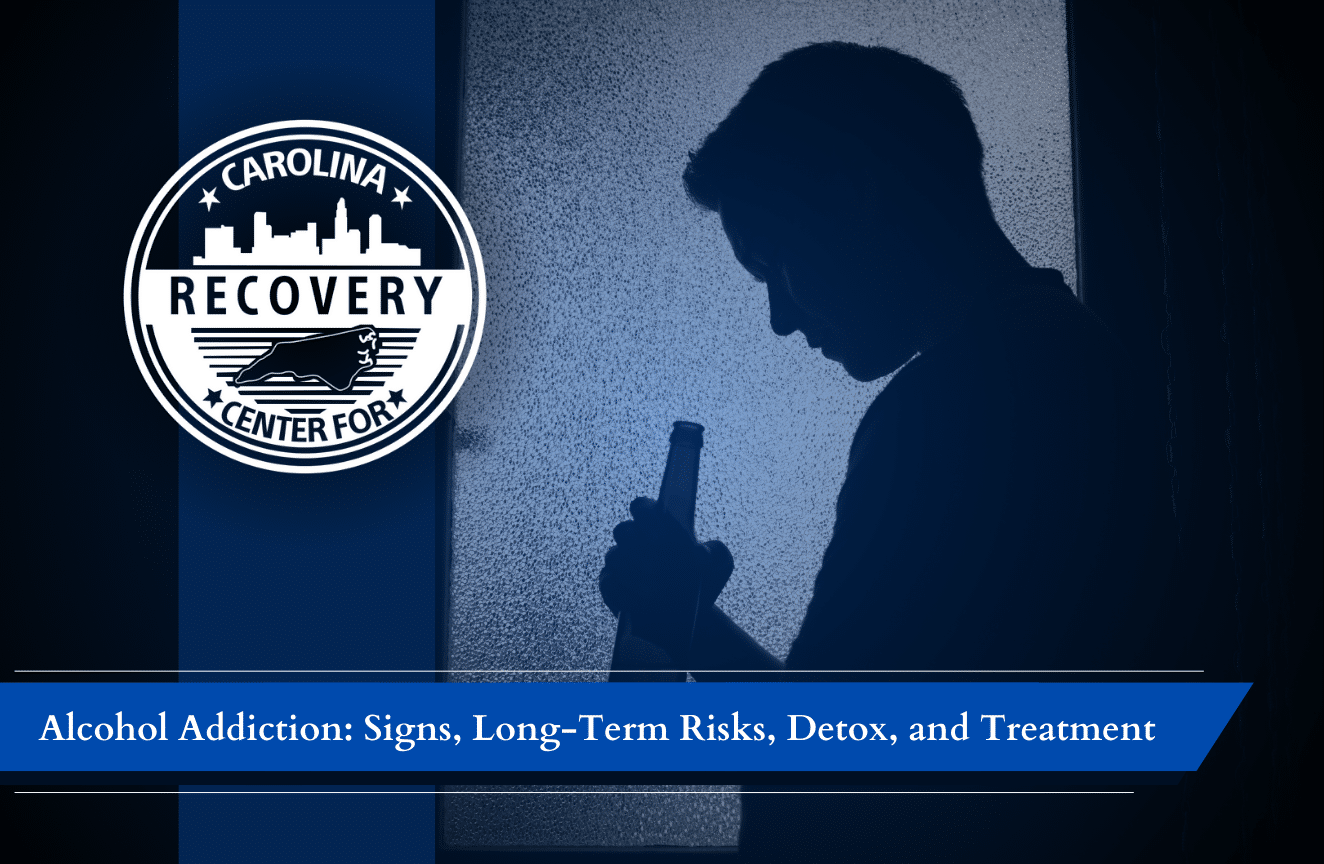


Alcohol use is common and widely accepted in most areas of the United States, and many people struggle with unhealthy drinking habits. Some people misuse alcohol by drinking too much, and some develop alcohol addiction.
Alcohol addiction can affect anyone, and many factors can contribute to someone developing it. Prolonged periods of heavy drinking can cause changes in the brain that make it very difficult for someone to control their actions or stop drinking when they choose.
Early treatment can give people the chance to overcome alcohol addiction and embrace a healthier, sober lifestyle. This guide will provide an overview of alcohol addiction, how to recognize the signs of this condition, and how it is treated.
Reach out to the team at the Carolina Center for Recovery now to learn about our comprehensive alcohol addiction treatment programs.
Alcohol addiction is also known as alcohol use disorder (AUD) and alcoholism. It is a condition that affects millions of people in the United States. People living with alcohol addiction often face severe harm to their mental and physical health, as well as social, legal, and financial consequences.
Alcohol addiction can present itself in many ways, depending on the severity of the disease and the amount a person drinks. Alcohol addiction shows up in people’s lives differently. Some people may drink heavily every day, and some may binge drink between periods of sobriety.
Alcohol addiction can negatively impact a person’s life, regardless of how the addiction is exhibited. People with alcohol addiction often lose control over their drinking and may be unable to remain sober without significant interventions, treatment, and ongoing support.
According to the 2022 National Survey on Drug Use and Health (NSDUH), 221.3 million people ages 12 and older (78.5%) reported that they drank alcohol at some point in their lifetime. Because alcohol use is so common in the United States, it can be difficult for some people to determine when their drinking has crossed the line and become problematic. The Centers for Disease Control and Prevention (CDC) provides guidelines about alcohol consumption that can help people determine when their drinking habits have become unhealthy.
According to the CDC, people who choose to consume alcohol must drink in moderation. Moderate drinking is defined as:
A “drink” does not mean any beverage that contains alcohol. The CDC defines a “drink” as:
These units of measurement can help you determine if your alcohol consumption exceeds the level of moderate drinking.
Heavy drinking is associated with many emotional and physical health problems, including an increased risk for certain cancers, cardiovascular problems, liver disease, depression, and more. More than 16.1 million people engage in heavy drinking each month. The CDC defines heavy drinking as:
Binge drinking is another problematic pattern of alcohol consumption that involves drinking a large amount of alcohol in a short period. People who engage in binge drinking are at increased risk for injuries and accidents and may be more likely to be involved in an assault or other crimes. In 2022, an estimated 23.5% of people ages 18 and older report binge drinking in the past month.
Binge drinking and heavy drinking can increase a person’s risk of developing alcohol addiction. It’s important to evaluate your drinking habits and limit your alcohol consumption honestly. If you find that it’s challenging to reduce your drinking or stop altogether, you may need treatment for alcohol addiction.
It can be challenging to identify alcohol addiction because alcohol is widely available, and drinking is generally acceptable in many cultures throughout the United States. Still, more than 29.5 million people ages 12 and older in the U.S. had an AUD in 2022.
However, alcohol addiction can cause noticeable changes in a person’s appearance and behavior. Recognizing the signs of alcohol addiction early can help you or a loved one get treatment quickly.
Some common signs of alcohol addiction include:
Alcohol addiction gets worse over time unless people receive treatment. Look for the signs of alcohol addiction and seek treatment as soon as you recognize a problem.
Long-term alcohol abuse and alcoholism can have severe and widespread effects on both physical and mental health, as well as various aspects of an individual’s life. Here are some of the potential long-term consequences of alcoholism:
Detoxification is often the first step in treating alcohol use disorder. Withdrawal from alcohol can be a challenging and potentially dangerous process, requiring medical supervision. Withdrawal symptoms typically begin within a few hours to a day after the last drink and can last for up to a week. However, the timeline and intensity of symptoms can vary based on factors such as the individual’s level of alcohol dependence and overall health.
Common symptoms of alcohol withdrawal include:
DTs are a severe form of alcohol withdrawal that may include hallucinations, confusion, seizures, and intense autonomic nervous system hyperactivity. DTs can be life-threatening and require immediate medical attention.
Many people begin treatment in a medically-supported detox program that provides medications to manage withdrawal symptoms, supervision, and emotional support during detoxification. Detox may involve medications that can alleviate withdrawal symptoms and reduce the risk of complications. Benzodiazepines are commonly used to manage anxiety and seizures during alcohol detox.
After a safe, complete detox, people must receive treatment to address the complex underlying roots of their drinking.
People may develop unhealthy drinking habits that lead to addiction for many reasons. In many cases, people may drink heavily to dull feelings of emotional pain or discomfort. In others, there may be genetic or environmental factors that contribute to their alcohol addiction. And in most cases, the reasons behind alcohol addiction are very complex.
As a result, alcohol addiction treatment plans are personalized to meet each person’s needs. Before beginning treatment, people undergo an assessment to determine which level of care and course of treatment they need to succeed in recovery.
Inpatient or outpatient alcohol rehab programs offer structured environments for individuals to focus on recovery. Inpatient programs provide intensive, 24-hour care, while outpatient programs allow individuals to receive treatment while living at home.
Treatment plans often include counseling, behavioral therapies, group support, medications, and education. Various therapeutic approaches, such as cognitive-behavioral therapy (CBT), motivational enhancement therapy (MET), and contingency management, are used to address the psychological aspects of addiction, identify triggers, and develop coping skills.
Throughout treatment, individual counseling and group therapy provide emotional support, help individuals explore the underlying causes of their addiction, and foster a sense of community. Support groups like Alcoholics Anonymous (AA) can be beneficial during treatment and after, supporting long-term recovery.
Carolina Center for Recovery is a state-licensed and CARF (Commission on Accreditation of Rehabilitation Facilities) accredited alcoholism treatment facility. We are a dual-diagnosis facility with a primary focus on substance abuse. We offer individualized, extended-term treatment in an intimate setting located in Charlotte, NC.
We take a holistic approach to treating alcohol addiction, offering a variety of treatment modalities centered around identifying and resolving the underlying issues associated with the addiction. Each client enrolled in our program will receive individual attention from a therapist and psychiatrist as well as gaining exposure to a multitude of traditional and alternative therapies.
If you or a loved one are struggling with a drinking problem and ready to take the first steps toward recovery, please contact us today.